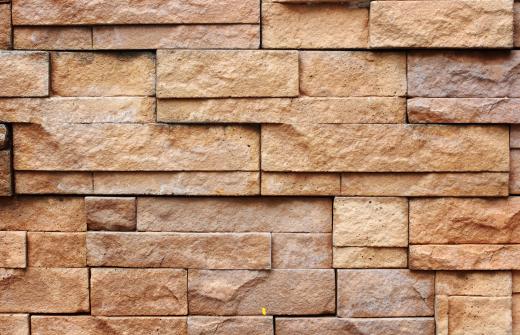Clay brick is a very popular building material used in the construction of residential, commercial, and industrial structures. Although refinements have been made in the brick manufacturing process, it remains largely unchanged from the manufacture of the earliest bricks, estimated to be around 10,000 years ago in the Middle East. Indeed, brick-making in underdeveloped areas of the world is indistinguishable from what took place thousands of years ago. The size of bricks remains largely unchanged as well, although variations exist among regions, which may be reflective of the fact that larger bricks will provide greater insulation in colder regions.
Clay brick is made by mixing clay with water and an aggregate such as sand to prevent shrinkage and provide bulk. The mud is worked to a relatively thick consistency, pressed into forms and fired in a kiln at temperatures as high as 1,832 degrees Fahrenheit (1,000 degrees Celsius). Many different processes and procedures have been developed for the firing process, and modern brick factories can turn out millions of bricks every year. Another source of brick is recycling; when brick structures are demolished, the intact bricks are routinely collected and re-used.

In addition to construction, clay brick has also been used as paving, but in the age of automobiles, has proved to be incapable of bearing the load. Streets worldwide that were originally brick have either been paved over or replaced. Brick pavers are popular in residential applications, though, in such features as patios and walkways. Likewise, many cities are experimenting with clay brick paving as a way of introducing an aesthetically pleasing element to pedestrian areas.

In the United States, clay brick is prized as a building material for its insulating properties, its attractiveness, and its durability. Many historic structures, such as Philadelphia’s Independence Hall, boast brick construction. At less than 300 years old, though, Independence Hall is a relative newcomer to the long list of ancient brick structures to be found in Europe. As the Roman Legions spread their empire, they brought with them portable kilns to fire bricks, and examples of Roman brickwork can be found throughout the continent. In the United Kingdom, for example, brick was almost exclusively used for centuries. Similarly, bricks and brick structures have been discovered in China that are almost 4,000 years old.
When brick is used to make load-bearing walls, the walls on the lower floors of a structure must support the weight of the upper floors; thus, the taller the structure, the thicker the walls must be on the lower floors. For example, Chicago’s Monadnock Building, which opened in 1896, is a brick structure of 17 stories, but the walls on the ground floor are almost 6 feet (1.8 meters) thick. It was this inefficient use of space that led to the use of iron, and later steel, for the framing of tall structures; when such structures have brick exterior walls, they’re simply built up around an already-standing iron or steel frame, and are not load-bearing.
In modern times, many different materials have been developed that are practical alternatives to clay brick in terms of cost, ease of installation, and insulation properties. Few such applications match brick’s durability, however, and the look and feel of brick remain highly attractive. Both for light-duty paving applications and construction, brick remains popular.
